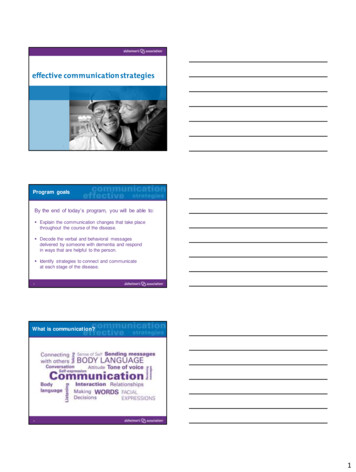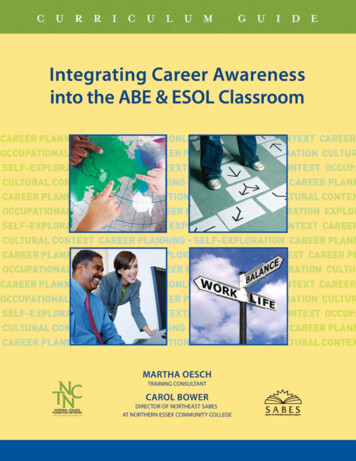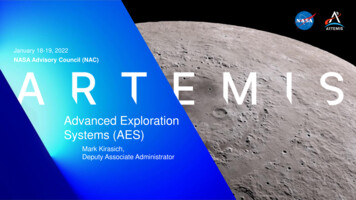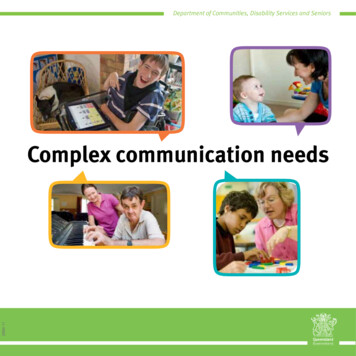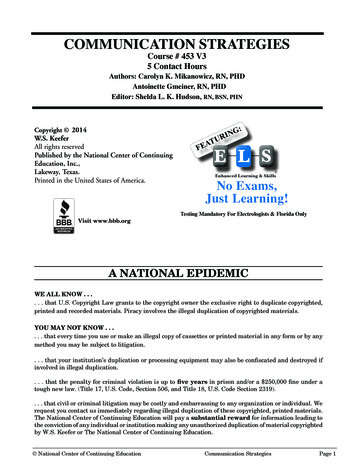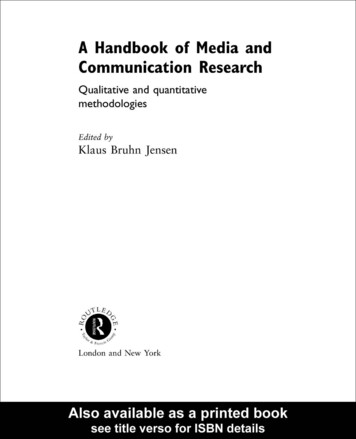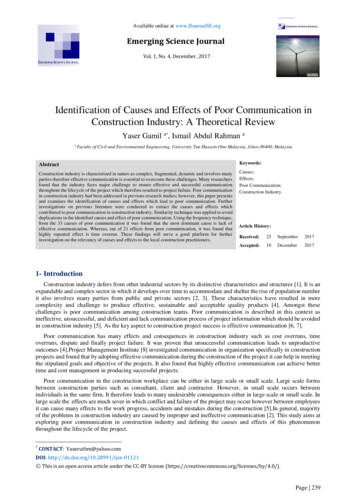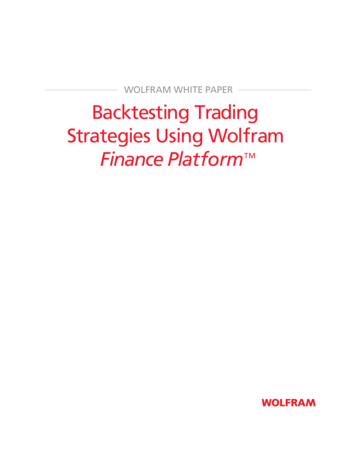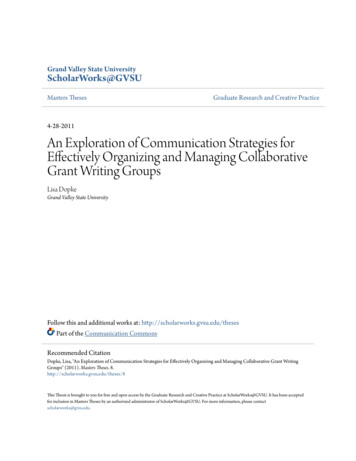
Transcription
Grand Valley State UniversityScholarWorks@GVSUMasters ThesesGraduate Research and Creative Practice4-28-2011An Exploration of Communication Strategies forEffectively Organizing and Managing CollaborativeGrant Writing GroupsLisa DopkeGrand Valley State UniversityFollow this and additional works at: http://scholarworks.gvsu.edu/thesesPart of the Communication CommonsRecommended CitationDopke, Lisa, "An Exploration of Communication Strategies for Effectively Organizing and Managing Collaborative Grant WritingGroups" (2011). Masters Theses. 8.http://scholarworks.gvsu.edu/theses/8This Thesis is brought to you for free and open access by the Graduate Research and Creative Practice at ScholarWorks@GVSU. It has been acceptedfor inclusion in Masters Theses by an authorized administrator of ScholarWorks@GVSU. For more information, please contactscholarworks@gvsu.edu.
Running Head: COLLABORATIVE GRANT WRITINGAn Exploration of Communication Strategies forEffectively Organizing and Managing Collaborative Grant Writing GroupsLisa C. DopkeA Thesis Submitted to the Graduate Faculty ofGRAND VALLEY STATE UNIVERSITYInPartial Fulfillment of the RequirementsFor the Degree ofMaster of Science in CommunicationsCollege of Liberal Arts and SciencesApril 2011
To my children, Alison and KyleI hope this work will provide encouragement, for you both,to aim high in pursuit of your dreams.i
ACKNOWLEDGEMENTSI offer my sincere gratitude to my Chair, Dr. Alex Nesterenko. Thank you for your advice andguidance.A very special thank you to Dr. Ric Underhile for the time you spent reviewing my work andproviding me with insightful feedback, which helped shape the final manuscript in a verymeaningful way.I wish to extend my gratitude to Dr. Roy Winegar. Thank you for your support of my thesisproject.I would also like to thank Mike, for the continued encouragement.Finally, I owe much gratitude to William, for your continued support of my academic pursuits,and your friendship.ii
TABLE OF CONTENTSABSTRACT. ixCHAPTER I . 1Introduction . 1Statement of the Problem . 3Purpose of the Study . 4Significance of the Study . 4CHAPTER II. 5Review of the Literature . 5Defining “Collaborative Writing”. 8Overview of the Collaborative Grant Writing Process . 8Characteristics Unique to the Collaborative Grant Writing Context . 10Processes Parallel to Proposal Writing . 10Theories of Small Group Decision Making . 12Pre-Collaborative Tasks . 15Phase 1: Orientation . 15Role Assignment . 16Creation of a Work Plan & Timeline . 17Selection of the Mode for Document Management . 17Communication Plan. 18Phases 2 and 3: Conflict and Emergence . 18Phase 4: Reinforcement . 20Conclusion . 20CHAPTER III . 21Methodology . 21Research Design. 21Institutional Review Board Procedures . 21Scope . 22Sampling Methods . 22Data Collection . 24iii
Confidentiality . 25Interview Protocol . 26Data Coding Procedures . 29Analysis of the Data . 35Assumptions. 37Limitations . 37Delimitations . 39Operationalization of the Relevant Variables . 40Operationalization of Demographic Categories. 41Operationalization of Group Phases . 41Summary . 42CHAPTER IV . 43Analysis and Findings . 43Findings. 43Part I: Interview Participant Demographics . 44Participant Characteristics . 44Organizational Characteristics . 45Part II: Substantive Interview Questions . 45Pre-Collaboration . 46Internal Strategizing . 47Assess Internal Resources . 48Appraising the Political Landscape . 48Choosing Partners . 48Existing Relationship . 49Empowered to Make Decisions . 50Complimentary Resources . 50Connecting as a Newbie. 50Phase 1: Orientation . 51Role Assignment . 51Qualities of an Effective Leader . 52Social/Emotional Intelligence . 53iv
Focused Guidance . 54Managing the Work Process . 54Communication Plan. 55Action Plans . 56Document Management . 57Phases 2 & 3: Conflict and Emergence. 58Causes of Conflict . 60Budget Negotiation . 60Other Issues . 60Conflict Resolution Strategies . 60Face-to-Face Conversation (Group) . 60Face-to-Face Conversation (One-on-One) . 60Artificial Resolution. 61Unresolved Conflict . 61Breakdown in Communication . 61Phase 4: Reinforcement . 61Standard Protocols . 62Lack of Debriefing . 63Participant Reflection. 63Defining Success: New Opportunities . 63Summary of Findings . 64CHAPTER V . 72Discussion . 72Purpose of the Study . 72Significance of the Study . 72Review of Methods . 72Limitations . 73Overview of Findings . 74Discussion of Findings . 75Outside Factors . 75Internal Preparation . 76v
Project Management Strategies. 77Interpersonal Interactions. 77Best Practice Strategies for Managing Collaborative Projects . 78Pre-Collaboration Strategies . 78Internal Preparation . 79Choosing Partners . 79Orientation Strategies. 81Assigning Roles . 82Work Plans . 83Document Management . 84Communication Plan. 84Phases 2 and 3: Conflict and Emergence . 85Phase 4: Reinforcement . 87Professional Development Implications . 88Future Research Agenda . 89REFERENCES . 92APPENDICES . 98Appendix A: Interview Consent Form . 99Appendix B: Interview Script . 101vi
LIST OF TABLESTable 1: Primary Small Group Decision Making Theories . .12Table 2: Methods for Document Management . .17Table 3: Prerequisite Demographic Criteria . .23Table 4: Coding Tables . . .31Table 5: Participant Demographics. . .44Table 6: Organization and Grantor Demographics. .45Table 7: Pre-Collaboration Themes . . . .46Table 8: Pre-Collaboration Themes Related to Choosing Partners . .49Table 9: Role Typology for Collaborative Grant Writing Groups .51Table 10: Themes for Leadership Quality . .53Table 11: Orientation Task Strategies by Topic .55Table 12: Conflict and Emergence Themes . .59Table 13: Reinforcement Task Strategies .62Table 14: Aspects of Collaborative Work . . . .78Table 15: Interrelationship of Group Roles. .82vii
LIST OF FIGURESFigure 1: Collaborative Writing Communication Continuum .14Figure 2: Socio-Gram of Research Population .24Figure 3: Dynamics Influencing the Collaborative Writing Process. .75viii
ABSTRACTThe present research explored approaches to collaborative grant writing, as little isknown about the details or range of variation in the processes that are currently deployed byprofessionals working within this context. Findings were used to build a typology of the rolesspecific to collaborative grant writing groups, provide a discussion of ideal group compositionand leadership, and to identify and suggest ten best practice strategies for organizing andmanaging group dynamics and tasks during the phases of the collaborative writing process.ix
Collaborative Grant Writing 1CHAPTER IIntroductionRequired collaboration is becoming the norm for many organizations in pursuit of federalgrant funding, including institutions of higher education. While this may have always been thecase for research-based grants, mandatory collaboration, in which the type of partnerorganizations are designated by the department 1, has not traditionally been required for grantsthat fund educational programming, support services and/or educational outreach. However,many federal departments have perhaps begun to recognize that in order to achieve the greatestreturn on the public investment that grants represent, a comprehensive solution that taps into thevariety of resources available within a given community must be encouraged (Baker, Homan,Schonhoff & Kreuter, 1999). This commitment to protect taxpayer interests is set forth as part ofa department’s strategic plan, and reflects its priorities through integration of these interests withits mission and program authorities (Fund for the Improvement of Post-Secondary Education[FIPSE], CFDA# 84.116H, 2010).With that being the case, mandatory grant collaboration means that collaborative writinghas become the expectation for those charged with drafting the application, as a criticalcomponent of obtaining grant funding is the proposal document itself. The opportunity forcollaboration presents many advantages for writers such as maximum input, checks andbalances, access to a depth of experience, resources, joint knowledge, error reduction/achieving amore accurate text, and potentially, a higher quality document (Appel, 2005; Noël & Robert,2004). However, these benefits hinge upon the ability of the collaborative group as a whole tocarry out their interactions and subsequent writing tasks effectively. This is often simpler in1Required partners may include workforce development boards, industry/business, non-profit organizations thatprovide education-specific services such as literary councils or k-12 schools, and community or faith-based groups.
Collaborative Grant Writing 2theory than in practice, given that the turnaround time for most federal solicitations for grantapplications (SGA) is now thirty days from announcement in the federal register.When such collaborative structures are not already in place (i.e., “ an alliance amongindividuals linked by a common problem in order to develop a viable solution for addressing thatproblem”) (Crawley, Dopke, Hughes & Dolan, 2007, p. 184), creating an innovative programthat represents a “true collaboration” of organizational resources and ongoing reciprocity can bedifficult, if not impossible, to achieve within these constraints. Moreover, even when theunderlying structures for collaboration are in place, the communication required to orchestrate anoften diverse team through a successful grant writing endeavor, and subsequent projectimplementation (if funding is received), tends to be challenging from the outset for a number ofreasons. For example, group members from representative organizations may play diverse rolesand/or have different levels of influence within and outside of their organization (Bacon, 1990),leading to dissention in assignment of tasks. Partnering organizations also do not necessarilyshare similar missions and organizational acculturation (Palmeri, 2004), which dictate how andwhen work is accomplished. The group’s ability to mediate these, and other differences,therefore likely plays a significant role in whether or not they can achieve a successful outcome.In addition, “because collaborative work often places unique demands on participants requiring some unfamiliar attitudes and behaviors and a wide range of specialized skills collaborative capacity is greatly influenced by both the existing skills, knowledge and attitudesmembers bring to the table and efforts taken to build, support, and access this capacity” (FosterFishman, Berkowitz & Lounsbury, 2001, p. 243). In other words, not only is it is essential tostrategically select the group’s members, as each individual’s skills, talents and work habits mustprovide an added value to the whole, but the ability of the group to communicate and work
Collaborative Grant Writing 3together to achieve its collective purpose also largely depends on how effectively its dynamicsare organized and managed (i.e., to create conditions that promote collaboration).Navigating collaborative grant writing ventures is of utmost importance for institutions ofhigher education and other organizations seeking federal grant funding. The present researchtherefore explored approaches to organizing and managing group dynamics and tasks duringvarious phases of the collaborative writing process. Findings were used to identify best practicestrategies for organizing and managing group dynamics and tasks. It is anticipated that thesuggested strategies will increase the effectiveness of such groups at developing an innovativeprogram that can then be represented through a collective proposal document.Statement of the ProblemWhile the existing literature provides a broad overview of collaborative writing practicesacross a variety of settings, such strategies have yet to be established within the context ofcollaborative grant writing. This study sought to identify strategies for organizing and managinggroup dynamics and tasks within this context through the exploration of the following researchquestions:1. What information might help professionals to position themselves and their organizationfor success as they prepare to embark on collaborative grant writing endeavors?2. What strategies are being deployed by professionals who participate in collaborativegrant writing activities to organize and manage group dynamics (i.e., managinginterpersonal communications, negotiating conflict, assigning roles, establishing acommunication plan, and debriefing)?3. What strategies are being deployed by professionals who participate in collaborativegrant writing activities to organize and manage group tasks (i.e., information collection,document management, and writing tasks)?
Collaborative Grant Writing 4Purpose of the StudyLittle is known about the details or range of variation in the processes currently usedwithin the collaborative grant writing context. Therefore, the purpose of this research was toexplore and identify best practice strategies for organizing and managing group dynamics andtasks within this context. The strategies discovered are presented within the framework ofFisher’s (1970) theory of small group decision making in an effort to suggest how particularstrategies, when deployed at strategic points, might help the group move through thecollaborative and writing processes more efficiently. The theory provided the framework forcreating a continuum, or visual representation, of the phases of the collaborative writing process.In this sense, Fisher’s theoretical phases of group decision making provided a general timeframefor deploying a particular strategy in order to achieve a specific outcome. For example, thestrategy of internal planning, when conducted by an organization in anticipation of collaborating(i.e., the pre-collaborative phase), sets the stage for successful group work.Significance of the StudyWhile past research on collaborative writing has served to inform the development ofbest practices for a range of collaborative writing scenarios, additional research was necessaryfor identifying and establishing strategies that provide collaborative grant writing groups with thetools they need to work more efficaciously. The topic was deemed both timely and relevant asmany federal departments now require collaborative partnerships in conducting grant activities.This necessitates the development of such strategies to ensure the success of these endeavors.
Collaborative Grant Writing 5CHAPTER IIReview of the LiteratureA review of the literature reveals that collaborative writing as a subject of inquiry beganin the late 1980s (Noël & Robert, 2004). Over the past decades such research has explored thetopic in a variety of ways. For example, researchers have examined the writing strategies used bycollaborative writing groups (Noël & Robert, 2004; Stratton, 1989), the assignment of grouproles (Nelson & Smith, 1990; Stratton, 1989), the influence of gender (Lay, 1989), the use ofcollaborative writing assignments in business communications courses (Scheffler, 1992; Duin,1990; Nelson & Smith, 1990), and the impact on, and use of, technology in collaborative writingendeavors (Jones, 2005; Sakellariadis, et al., 2008). The majority of these studies have beenqualitative in nature, using case studies, open-ended interviews and surveys, or a combinationthereof, to explore the topic and establish a basis for understanding collaborative writingprocesses in these various contexts. Yet, even with several aspects of this topic having beenexplored, many inconsistencies remain; thus, the information that we have about collaborativewriting tends to be somewhat fragmentary and unfocused (Allen, Atkinson, Morgan, Moore &Snow, 1987).One reason for inconsistencies across research may be that there has been little agreementin defining the term collaborative writing (Beck, 1993; Lowry, Curtis & Lowry, 2004). Forinstance, Duin (1990) defined collaborative writing as “ a process that requires support formore than just the exchange and maintenance of information” (p. 45), while Jones (2005) definedit “ as interaction by an author or authors with people, documents, and organizational rules inthe process of creating documents” (p. 450). In addition, seemingly synonymous terms are usedthroughout the literature such as cooperative writing, group authoring and co-authoring (Lowry,
Collaborative Grant Writing 6et al., 2004), which is indicative of the numerous iterations that exist with respect tocollaborative writing endeavors. Consequently, these variations make it difficult to interpret thefindings of the existing research with any degree of specificity (Allen, et al., 1987; Lowry, et al.,2004). What has been established, however, is the difficult nature of writing collaboratively, thewide range of strategies groups use for producing a collective document, roles that emerge as agroup moves through stages of interaction and the writing process, and the influence andfunctions of interpersonal communication within collaborative writing groups.One suggestion nearly all researchers agree upon is that collaborative writing is asdifficult as it is complex, and that it involves both social and intellectual aspects. Thiscomplexity is well illustrated in the following discussion by Kraut, Galegher, Fish & Chalfonte(1992):Socially, collaborative writing requires that group members establish shared achievementgoals, that they divide tasks among themselves keeping in mind both concerns forfairness and differences in individual skills, and that they resolve questions of authoritywithin their group. Intellectually, it requires that group members establish sharedrhetorical goals and a common understanding of the facts on which the document is to bebased. They must also solve high-level writing problems To meet these social andintellectual challenges, group members must also contend with considerable proceduralcomplexity. That is, they must adopt procedures that will enable them to get their worklaunched; to circulate draft versions among group members; and to refer to specificportions of their documents as pieces of text are created, revised, and incorporated into aunified whole. To launch their work, group members must be able to coordinate theirconversation well enough t
I offer my sincere gratitude to my Chair, Dr. Alex Nesterenko. Thank you for your advice and guidance. A very special thank you to Dr. Ric Underhile for the time you spent reviewing my work and providing me with insightful feedback, which helped shape the final manuscript in a very meaningful way. I wish to extend my gratitude to Dr. Roy Winegar.
